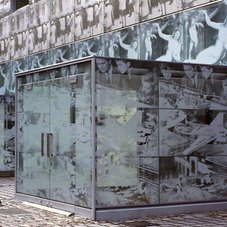Every decision we make as consumers has environmental consequences. Architecture and fashion can no longer be consumed strictly on the basis of design. As architect David Hertz has remarked, “Green building should not come at the expense of good design.”
In terms of sustainable architectural design and innovation, skyscrapers in New York and other cities offer an exciting vision of the future. Innumerable architects are working with innovative energy conservation strategies, ie. with the reuse of buildings and materials and reducing energy consumption.
Reusing high schools, manufacturing lofts, and banks, by converting these to residential dwellings has become a major trend in the U.S. and abroad. As oil prices continue to affect the suburban lifestyle, clustering and multi-dwelling mixed with commercial are essential.
Bothe, Richter & Teherani’s Bürohaus Berliner Bogen in Hamburg conserves energy via its glass “jacket” protecting the building core within. LoTek recycles shipping containers as prefabricated housing. Salvaged buildings and products save resources and energy, exemplified by David Hertz’s Rehwald Project, using a defunct Boeing 747 airplane or Garrett Smith’s Royal Fork project (see photograph above) in New Mexico. Building components that reduce heating and cooling loads such as structural insulated panels (SIPs), insulated concrete forms (ICFs), autoclaved aerated concrete (AAC) blocks, and high-performance windows and glazings are becoming de rigueur.
Often the technology to reduce energy use is initially developed by military/industrial complexes, and while ecomodista deplores violence and aggression, benefits may coexist. Iowa Thin Film Technologies, Inc., has completed the development of integrated solar technology for US Armed Forces tent prototypes, integrating the company’s Power Film, flexible solar panels. directing with the tent fabric.
In terms of sustainable architectural design and innovation, skyscrapers in New York and other cities offer an exciting vision of the future. Innumerable architects are working with innovative energy conservation strategies, ie. with the reuse of buildings and materials and reducing energy consumption.
Reusing high schools, manufacturing lofts, and banks, by converting these to residential dwellings has become a major trend in the U.S. and abroad. As oil prices continue to affect the suburban lifestyle, clustering and multi-dwelling mixed with commercial are essential.
Bothe, Richter & Teherani’s Bürohaus Berliner Bogen in Hamburg conserves energy via its glass “jacket” protecting the building core within. LoTek recycles shipping containers as prefabricated housing. Salvaged buildings and products save resources and energy, exemplified by David Hertz’s Rehwald Project, using a defunct Boeing 747 airplane or Garrett Smith’s Royal Fork project (see photograph above) in New Mexico. Building components that reduce heating and cooling loads such as structural insulated panels (SIPs), insulated concrete forms (ICFs), autoclaved aerated concrete (AAC) blocks, and high-performance windows and glazings are becoming de rigueur.
Often the technology to reduce energy use is initially developed by military/industrial complexes, and while ecomodista deplores violence and aggression, benefits may coexist. Iowa Thin Film Technologies, Inc., has completed the development of integrated solar technology for US Armed Forces tent prototypes, integrating the company’s Power Film, flexible solar panels. directing with the tent fabric.








